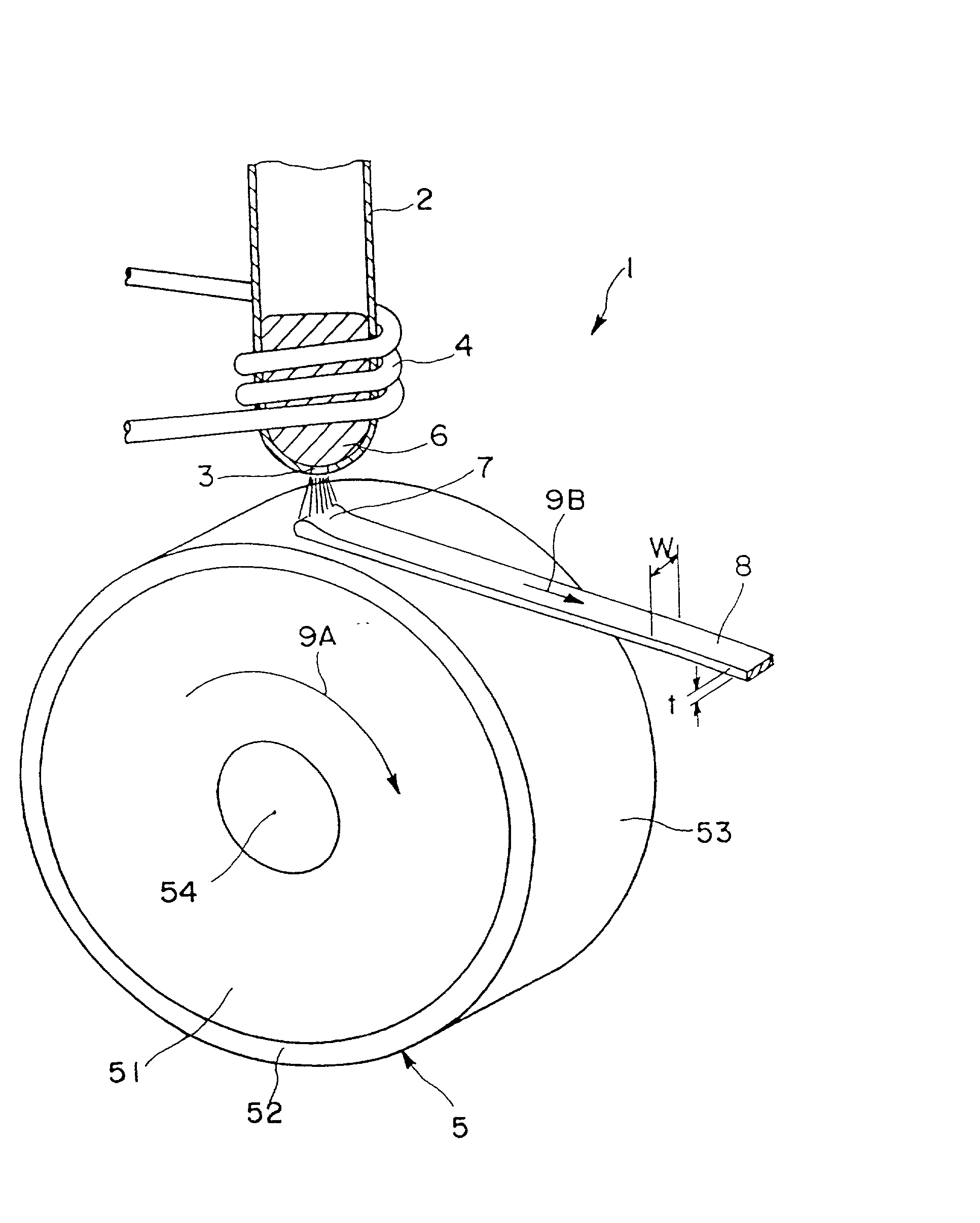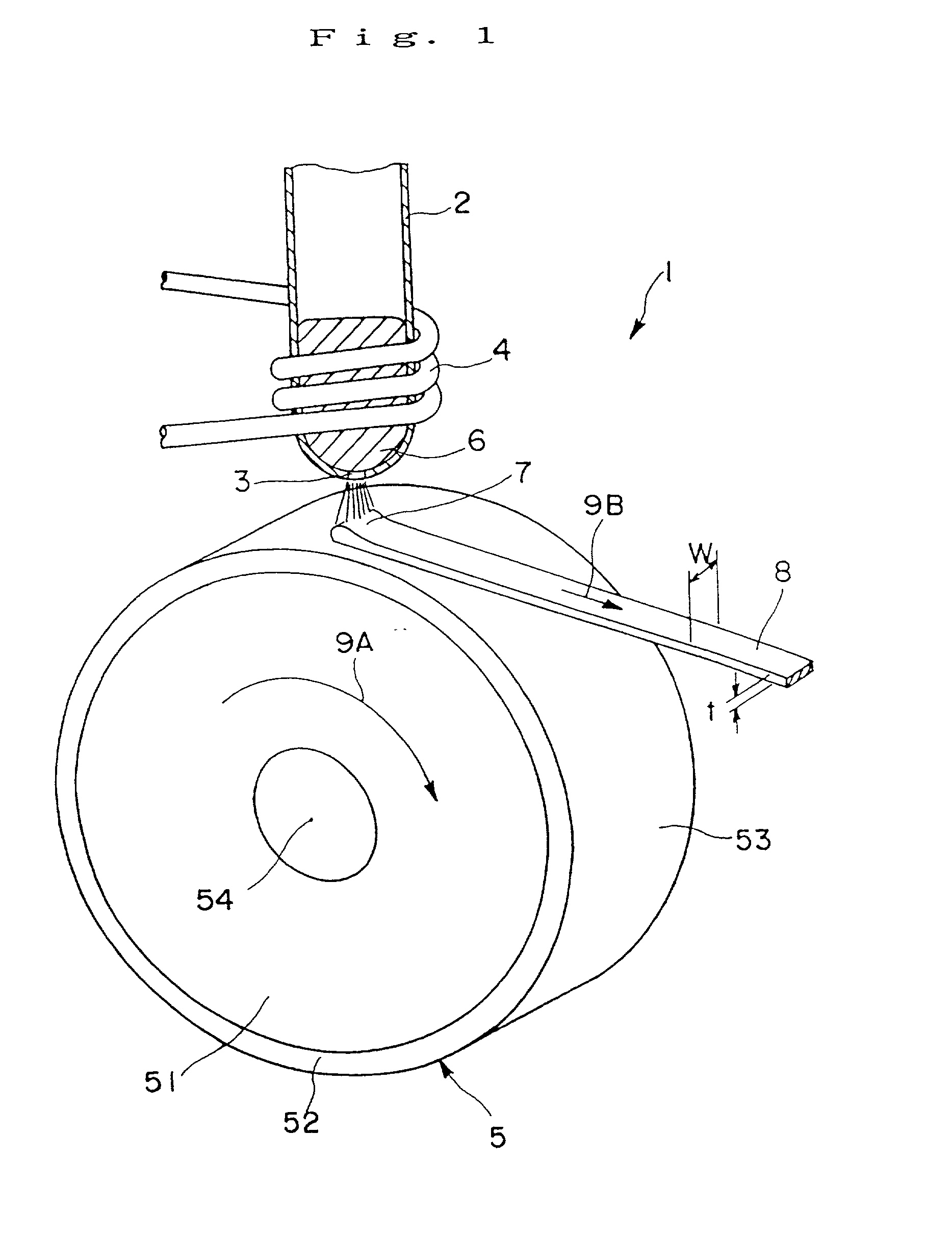Method of manufacturing magnet material, ribbon-shaped magnet material, magnetic powder and bonded magnet
a technology of ribbon-shaped magnets and manufacturing methods, which is applied in the manufacture of magnetic materials, magnetic bodies, inductance/transformers/magnets, etc., can solve the problems of large amount of melt spun ribbon, insufficient magnetic properties of bonded magnets manufactured by using these magnetic powders, and differences in microstructure, etc., to achieve excellent magnetic properties, high magnetic properties, and relatively high magnetic flux density and coercive force of magnetic powders
- Summary
- Abstract
- Description
- Claims
- Application Information
AI Technical Summary
Benefits of technology
Problems solved by technology
Method used
Image
Examples
embodiment 1
[0133] (Embodiment 1)
[0134] A melt spun ribbon with alloy composition Nd.sub.9.1Fe.sub.balCo.su-b.8.5B.sub.5.5Al.sub.0.2 was obtained according to the following method.
[0135] First, each of the materials Nd, Fe, Co, B and Al was weighed, and then their mixture was melted and cast in an Ar gas in a high frequency induction melting furnace to obtain a mother alloy ingot. Then, a sample of about 15 g was segmented from the ingot.
[0136] A melt spinning apparatus 1 as shown in FIG. 1 to FIG. 3 was prepared, and the sample was placed in a quartz tube 2 having a nozzle (a circular orifice having a diameter of 0.6 mm) 3 at the bottom.
[0137] As for the cooling roll 5, a roll (radius 100 mm) provided with the surface layer 52 of ZrC of a mean thickness 5 .mu.m formed by sputtering on the outer periphery of the copper-made base part 51, was manufactured, and the peripheral surface 53 of the cooling roll was finished by surface grinding so as to have a surface roughness Ra of 0.5 .mu.m.
[0138] A...
example 2
[0158] As the cooling roll for the melt spinning apparatus 1, a cooling roll (with radius 120 mm) provided with the surface layer 52 having a constituent material, thickness, and surface roughness Ra shown in Table 1 was manufactured by sputtering on the outer periphery of the copper base part 51. The cooling rolls indicated by the sample Nos. 11 and 12 were respectively provided with laminates of two ceramic layers (layer A and layer B) with different compositions (layer A is the outermost layer and layer B is on the base part 51 side) as their surface layers 52.
[0159] By rotating these cooling rolls at a peripheral velocity of 19 m / s, melt spun ribbons with alloy composition represented by Nd.sub.6.5Pr.sub.1.8Dy.sub.0.7Fe.sub.balCo.sub.7.8B.sub.5.4Si.sub.1.0Al.s-ub.0.2 were manufactured in the same way as in Example 1. The mean thickness t of the obtained melt spun ribbon and the contact time (calculated in the same way as in Example 1) of the melt spun ribbon with the peripheral ...
example 3
[0165] Bonded magnets were manufactured in the same manner as that of Examples 1 and 2 except that the bonded magnets were manufactured by extrusion molding, and then the magnetic properties thereof were measured in the same manner as that of Examples 1 and 2. In this Example, a result similar to the above was obtained.
PUM
| Property | Measurement | Unit |
|---|---|---|
| time | aaaaa | aaaaa |
| thickness | aaaaa | aaaaa |
| radius | aaaaa | aaaaa |
Abstract
Description
Claims
Application Information
 Login to View More
Login to View More - R&D
- Intellectual Property
- Life Sciences
- Materials
- Tech Scout
- Unparalleled Data Quality
- Higher Quality Content
- 60% Fewer Hallucinations
Browse by: Latest US Patents, China's latest patents, Technical Efficacy Thesaurus, Application Domain, Technology Topic, Popular Technical Reports.
© 2025 PatSnap. All rights reserved.Legal|Privacy policy|Modern Slavery Act Transparency Statement|Sitemap|About US| Contact US: help@patsnap.com



